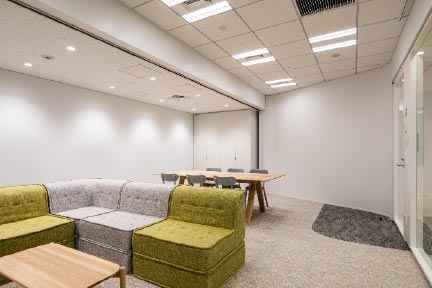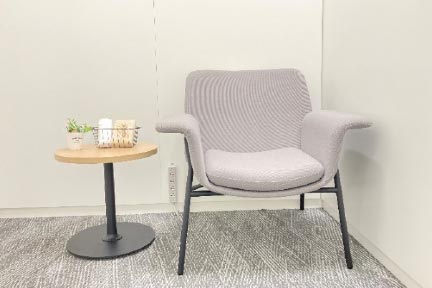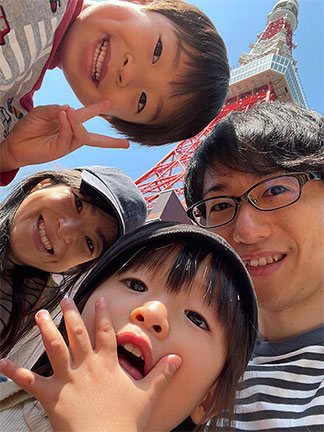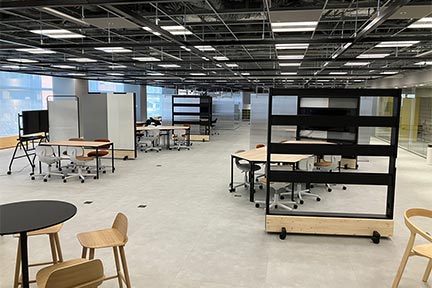In our efforts to contribute to the realization of a better life and society, we believe it is important for our employees to feel empowered and fulfilled in their everyday lives. The Lion Group provides various types of support aimed at helping each individual achieve a sustainable work style to ensure mutual quality enhancement and synergy between work and lifestyle, so that employees can further enrich their lives.
We are committed to helping each employee realize their personal aspirations for the medium to long term as well as the day-to-day lifestyles they desire.

For individual employees to be able to continue working with peace of mind over the long term, it is necessary to expand the range of life planning options for events that have a large impact on life, such as nursing care and childcare.
Lion has enhanced support for employees engaged in nursing care of family members as part of efforts to create an environment that allows employees to continue to work with peace of mind while handling such responsibilities. In addition to ordinary annual paid leave, we have in place programs to support nursing care providers, including nursing care leave of up to 365 days, shorter work hours for nursing care (short hours flextime system), nursing care leave and accumulated leave for nursing care (accumulated expired annual paid leave). Furthermore, we have set up a support website targeting employees aged 40 and over to better provide information on nursing care, including videos of caregiving seminars for managers and individuals.
| Nursing care | 365 days of nursing care leave |
|
|---|---|---|
| Shorter work hours for nursing care (short hours flextime system) |
|
|
| Nursing care leave |
|
|
| Accumulated leave (Close relative nursing care) |
* Accumulated paid leave may also be taken for the employee’s own medical care or for volunteering |
Lion is proactively enhancing its programs that support employees who are balancing work and childcare. We are expanding related programs in line with our action plans based on the Act on Advancement of Measures to Support Raising Next-Generation Children and the Act on Promotion of Women’s Participation and Advancement in the Workplace and working to increase awareness among employees. As a result of these efforts, in 2023, 105% of eligible female employees (under the Act on Childcare Leave, Caregiver Leave, and Other Measures for the Welfare of Workers Caring for Children or Other Family Members, applicable to full-time employees only, full-time contract employees are excluded) took childcare leave. The number of male employees taking childcare leave is rising at 71% across a wide range of departments.*
* Based on calculations of the percentage of childcare leave, etc., used in accordance with the Child Care and Nursing Care Leave Law
| Childbirth | Maternity leave |
|
|---|---|---|
| Special leave for spouse’s childbirth |
|
|
| Childcare | Childcare leave for birth |
|
| Childcare leave |
|
|
| Shorter work hours for childcare |
|
|
| Exemption from overtime work |
|
|
| Leave to nurse sick children |
|
* Initial leave is the first leave taken, either for childbirth leave or childcare leave
When Lion relocated its head office in 2023, it installed family rooms and nursing rooms to enable employees who are raising children to work with peace of mind, as well as enable them to bring their children to work as necessary.


Perspectives of Employees Balancing Work and Childcare
I used Lion’s childcare leave in 2016 and again in 2019 when I gave birth to my children. Lion’s various support systems had been well established when I had my first child, but they were further strengthened for my second child, and I felt that they created a very comfortable working environment for mothers. I was very anxious about returning to work after childcare leave because I could not imagine a life of raising two children while working, especially considering that I have not only one child, but also my second child. However, when I attended the Back-to-Work Seminars, I heard stories from more experienced mothers and was able to get a better picture of what it is like to balance work and family life. Talking with other mothers who were returning to work at the same time made me feel like I could do my best, and Lion’s systems were being improved, so I was able to look at returning to work in a positive light.
I met my husband while working at Lion, and when I had my second child, he was also able to take childcare leave. The Company as a whole is very supportive of parenting, regardless of gender, so we were able to enjoy raising our children without hesitation, which I appreciated.
Now, I am currently utilizing the short hours flextime system, the full flex system, and the telecommuting system. In addition, my superiors and coworkers are very understanding, so I am able to work in a flexible manner, which is very helpful, I feel that I am truly blessed to be able to work while raising my children.

To achieve the daily lifestyles that employees seek, it is necessary to reduce overtime and long work hours, make the leave system more accessible and increase flexibility in work hours and locations.
We have been working to reduce long work hours and encouraging employees to take annual paid leave since 2010. We are promoting understanding through compliance training (e-learning) on work hour management. We are also working to achieve an 80% paid holiday acquisition rate.
Since 2015, we have implemented a work-from-home system that promotes flexible work styles not bound to specific workplaces. This was done with the aims of accommodating autonomous work styles in line with the diversity of our employees and increasing productivity. In January 2021, we reinforced our telecommuting and full-flex systems (eliminating core time and enabling employees to take discretionary off-the-clock breaks), giving employees the choice of when and where to work. This shift toward more independent work styles that accommodate diverse needs has resulted in a usage rate for these systems of around 50%. The practice of work styles suited to individual needs continues to take root, helping improve professional fulfillment. Furthermore, because it is difficult to enable production site employees to freely set their own hours, we have established a system for such employees to take time off in hourly increments, not only for child and nursing care, but also for things that do not require a lot of time off such as family pick-up and drop-off, going to the doctor or school events. This system makes it easier for employees to balance their private lives and work, helping to bolster motivation.

We have shifted from the traditional style of commuting to an office with assigned seating and set work hours to one utilizing ICT, which enables employees, depending on the nature of their work and their individual circumstances, to choose when and where they will carry out their job duties, whether it be in the office or at home.
We are continuing to cultivate an employee mindset focused on engaging in creative and high-value-added activities as well as foster a corporate culture that appreciates and rewards such efforts.


Since 2013, we have conducted an annual awareness and behavior survey of domestic Group employees in order to confirm changes in employee awareness and behavior, with the aim of achieving a state in which every employee feels fulfillment in their work. The results of the survey are used for measures to improve job satisfaction of employees.
Click here for results